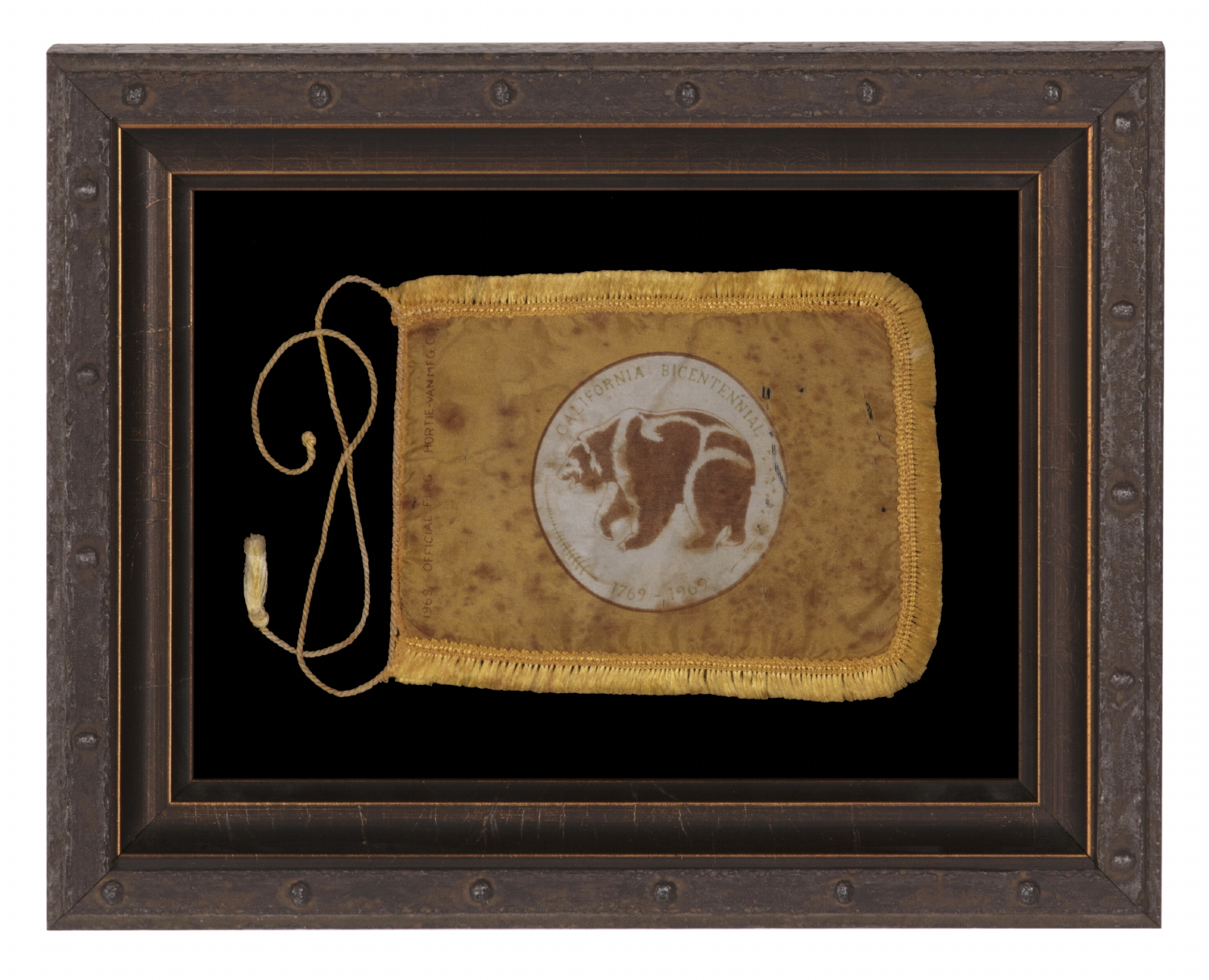
| |
CALIFORNIA BEAR FLAG VARIANT DESIGN, MADE IN 1969 FOR THE 200TH ANNIVERSARY OF THE OF THE FIRST EUROPEAN DISCOVERY OF THE SAN FRANCISCO BAY; THE ONLY EXAMPLE OF THIS TEXTILE THAT I HAVE EVER ENCOUNTERED |
|
| Available: |
Sold |
| Frame Size (H x L): |
10" x 12.5" |
| Flag Size (H x L): |
5" x 6.25" |
|
| Description....: |
|
Small parade flag, printed on silk, made for the bicentennial of the discovery of the San Francisco Bay by Spanish explorer Gaspar de Portolá, which took place on November 4th, 1769.
Set upon a gold ground, the device in the center of the flag appears to have been taken from a medallion, designed and minted in 1969 to commemorate the anniversary. This consists of the familiar bear from the California flag, above which are the words “California Centennial” and below which are the dates “1769-1969.”
Slightly in from the hoist end, the flag is signed with the following text: “1969 Official Flag; Hortie-Van Mfg. Co.” This is a small California flag-maker from Pasadena. There is a silk or rayon fringe surrounding three sides, also gold in color, but te most unusual feature of its construction is the long, twisted, gold cord stitched along the hoist, with a tassel at the top and knot at the bottom.
This is the only example of this flag that I have encountered. The gold color, bear flag-related imagery, attractive cord & tassel, in combination with the historical reference to California and San Francisco, result in a rather desirable object, in spite of the latter-20th-century date.
The Portolá expedition, which occurred between 1769–1770, was the first recorded, European, inland exploration of the interior of present-day California. Portolá, a Spanish military commander, had just been appointed governor of the Spanish colonial province “Las Californias,” which incorporated California, the Baja Peninsula, and other parts of both present-day Mexico and the United States.
Inhabited by Native Americans, the territory had previously been claimed by the Spanish Empire in 1542 via right of discovery, when an explorer named Juan Rodríguez Cabrillo visited the Pacific Coast. Cabrill laid claim in the name of Spain to the coastline as far north as forty-two degrees north latitude. A competing claim was established for England in 1579 by the privateer Francis Drake. In 1596, a Portuguese captain sailing for Spain, Sebastião Rodrigues Soromenho (Cermeño) explored some of the same coastline, recording notable features. The Portolá expedition carried a copy of Cermeño's writings to guide them along the coast.
Mounting: The flag was mounted and framed within our own conservation department, which is led by expert trained staff. We take great care in the mounting and preservation of flags and have framed thousands of examples.
The background is 100% cotton twill, black in color, which has been washed and treated for colorfastness. The mount was placed in a two-part frame that consists of an outer portion, made of wood, yet with a distressed finish that presents like rusted, antique iron. To this a scopped liner was added with a color like antiqued bronze. Spacers keep the textile away from the glass, which is U.V. protective. Feel free to contact us for more details.
Condition: There is significant foxing, but the flag presents beautifully because of it. |
|
|
|
| Collector Level: |
Intermediate-Level Collectors and Special Gifts |
|
| Flag Type: |
Parade flag |
|
| Star Count: |
|
|
| Earliest Date of Origin: |
1969 |
|
| Latest Date of Origin: |
1969 |
|
| State/Affiliation: |
California |
|
| War Association: |
|
|
| Price: |
SOLD |
|
| |
Views: 99 |
|
|
|

